A sudden flutter in the chest. Cramping muscles after a long workout. A sense of weakness that doesn’t quite go away. These subtle warnings often lead clinicians to a familiar laboratory finding low potassium levels. When this happens, one specific label comes into play in medical documentation: E87.6, the ICD-10 code for hypokalemia.
Why the ICD-10 Code for Hypokalemia Matters
Every diagnosis tells a story, and in healthcare, coding ensures that story is recorded accurately. The ICD-10 code E87.6 identifies hypokalemia, a condition defined by a drop in blood potassium below the normal range of approximately 3.5 to 5.5 mmol/L. Correctly coding this diagnosis is about more than insurance claims or hospital records. It allows physicians, researchers, and healthcare administrators to track patterns, plan treatments, and monitor outcomes with precision.
For hospitals and clinics, accurate coding supports quality metrics, reduces errors in billing, and ensures patients receive appropriate follow-up care. For patients, it creates a reliable record that follows them across specialists and facilities, allowing continuity of care no matter where treatment is received.
The Role of Potassium in the Body
Potassium is a critical electrolyte that regulates how nerves send signals, how muscles contract, and how the heart maintains its rhythm. Even a slight dip can disrupt the fine balance of these systems. Mild cases of hypokalemia may pass unnoticed, but when potassium levels drop significantly, patients can experience symptoms that range from muscle cramps and fatigue to dangerous arrhythmias.
The body relies on dietary intake and kidney regulation to maintain potassium balance. Factors such as diuretic use, gastrointestinal losses, or chronic illnesses can push this system off course, making careful monitoring and accurate diagnosis essential.
Decoding E87.6 in Clinical Settings
When a lab test confirms potassium levels below the normal threshold, physicians often document hypokalemia in the patient’s chart. Assigning E87.6 signals this diagnosis to every part of the care chain, from internal hospital systems to insurance claims.
And it’s not just about one note in a file. Accurate documentation with E87.6 supports:
- Clinical communication between providers during transitions of care
- Research data that helps track public health patterns
- Administrative accuracy for billing and claims processing
Consistency in coding ensures the diagnosis is recognized and appropriately managed across every point of care.
Common Causes of Hypokalemia
Hypokalemia rarely exists in isolation. Among the most common causes are:
- Excessive loss through the gastrointestinal tract, such as vomiting or diarrhea
- Medications, particularly diuretics prescribed for hypertension or heart failure, excessive intake of insulin or salbutamol
- Chronic kidney conditions, which can impair the body’s ability to retain potassium
- Endocrine disorders, including hyperaldosteronism
- Inadequate dietary intake, often in combination with other stressors
Each cause influences how the condition is treated and whether the code E87.6 stands alone or is accompanied by other diagnosis codes for underlying conditions.
Documentation and Coding Accuracy
Assigning the ICD-10 code for hypokalemia isn’t simply about noting “low potassium.” Complete and precise documentation captures:
- Laboratory confirmation of levels below the normal range
- Relevant symptoms, such as weakness, muscle cramps, or irregular heartbeat
- Potential triggers, from medication use to chronic disease
- Treatment plans, including oral or intravenous potassium supplementation
This level of detail not only reduces the risk of denied claims but also strengthens clinical care by ensuring every member of the care team has a full picture of the patient’s health.
The Global Perspective
Healthcare doesn’t stop at national borders. Patients frequently travel for advanced treatments, elective surgeries, or even routine care in other countries. When they do, accurate coding ensures their medical history is understood globally.
In cross-border care, the E87.6 code provides a universal language for providers. A specialist in Singapore or Germany instantly recognizes the diagnosis and its clinical implications. This consistency becomes even more valuable in emergencies, where minutes matter and clear communication can save lives.
The Cost of Coding Errors
Mistakes in coding hypokalemia can have significant consequences. Incorrect or incomplete coding might lead to:
- Delays in insurance reimbursement
- Misinterpretation of clinical severity
- Gaps in care coordination, particularly for complex cases
It’s often said that “the devil is in the details,” and that idiom rings true here. Inaccurate coding can compromise not only billing but also patient safety.
Clinical Example
Consider a middle-aged patient visiting the emergency department with palpitations and fatigue. Lab results show potassium at 2.8 mmol/L, well below normal. The attending physician diagnoses hypokalemia due to prolonged diuretic therapy and initiates intravenous potassium replacement. In this scenario, the coding team assigns E87.6 for hypokalemia, alongside additional codes for the underlying condition prompting diuretic use.
This precision ensures that the treatment, follow-up monitoring, and future encounters are accurately documented in the patient’s record.
The Bigger Picture in Patient Care
Hypokalemia is more than a number on a lab sheet. It’s a marker of something deeper a medication effect, a chronic disease, or a sudden acute stressor. By coding it correctly, providers create a bridge between laboratory science and bedside care, turning raw data into actionable insights.
And as healthcare systems move toward more integrated digital records, the role of precise ICD-10 coding will only grow. Every correct entry builds a foundation for better analytics, smarter resource allocation, and safer care.
Final Thoughts
The ICD-10 code for hypokalemia, E87.6, represents more than a clinical shorthand. It’s an anchor for clear communication, accurate billing, and safer patient care. From emergency settings to chronic disease management, consistent coding ensures patients receive the attention and treatment they need, no matter where they are in the world.
Hypokalemia, though common, demands respect. Proper documentation and thoughtful coding turn a simple number into a powerful tool for health one that protects patients and helps providers deliver care with clarity and confidence.









